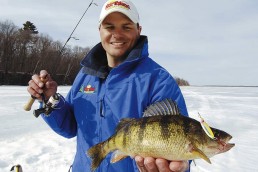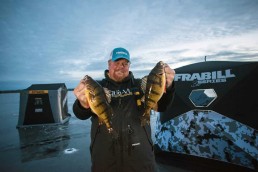Chasing down Jumbo Perch in Winter Weeds
SHARE THIS POST
Yellow perch swim in most of the lakes, rivers and reservoirs within the ice belt. This, combined with the excellent table fare, makes them a popular target once the winter temperatures deliver hard water to the region. So many of our favorite fisheries have clear water, sometimes even ultra-clear. This leads into one of the most fun, effective ways to target and catch jumbo perch through the ice.
Adult perch feed on invertebrates and small crayfish, but they are known to feed mostly on juvenile fish and minnows. These food sources will typically seek refuge among the cover. Cover can come in many shapes and forms, but the most significant source of almost any lake or system is weeds. And naturally, weeds need sunlight to grow, so this allows you to refine your focus on where to seek the perch.
Throughout winter perch can be found shallow cruising in weed beds and along the weedlines of the basin. Not only do they find their food here, but it also serves as a refuge, as they are on the menu for bass, walleyes, pike, muskies and trout.
Deeper weeds typically die off, making it ideal to target depths of 4 to maybe 12 feet (depending on water clarity). The best approach is to get out and explore, start at a good mid-depth, such as 8 feet. It may take a little time to find the ideal depth, so don’t be afraid to move around a little at first. You could use your Vexilar, or go “old school” and just use bobbers, but it is more fun and effective to sight-fish for them. This could be via an underwater camera or observing through the hole.
Using a 10-inch auger will give you a good-sized hole to sight-fish out of. I typically use my 8-inch StrikeMaster Laser and just drill two holes next to each other so it makes one larger hole. This makes a great “window” to the underwater world. It’s not necessary, but if you have an ice spud you can chip away any ice points that remain between the two holes. Any fish house will suffice to block out direct sunlight and allow you to see below. Of course, the darker the inside of the house, the better for you to see into the depths. Once your eyes adjust just take it all in courtesy of nature.
Are you enjoying this post?
You can be among the first to get the latest info on where to go, what to use and how to use it!
The best times are morning through the afternoon. This gives you maximum light for sight-fishing, but it is also the time when perch are most active. I have had many great trips in late morning to noon when they have been on the prowl.
There are many lures that will work on perch, such as small- to medium-sized profile spoons. Macho minnows and Buck-Shot Rattle Spoons tipped with a minnow head or a waxworm “chandelier” work great. However, soft plastics that have built-in action can be used with great success as well. The Northland Slug Bug or VMC Wax tail jig are fantastic baits for perch, as they closely match their forage. The rat-like tail looks so realistic when you jig it up and down in front of them. Watching them, you can see that once they see the bait, they kick it in gear to grab it before something else does.
Sight-fishing is akin to spearing, as it is a visual game where you are watching for the action to take place. When a perch drifts in, you get pumped up, and even more so when they notice your offering and come over to investigate. More often than not, they come in with reckless abandon and just smash it. This is particularly true when more than one comes into view as the competitiveness rises up among them. This is where it pays to have an artificial lure on so you can get back down to them before they move on—catching everything that comes into view is quite possible.
Don’t just sit in front of the television or tablet this winter, get out and drill some holes through the ice and watch nature happen right before your very eyes. It is an experience that you will not soon forget. And as an added bonus, you get to take home some tasty fish.
MWO
SHARE THIS POST
Did you enjoy this post?
You can be among the first to get the latest info on where to go, what to use and how to use it!
Steve Mattson
Steve Mattson has been writing articles for MidWest Outdoors since 2001. He is a driven angler, guide and sponsored tournament pro who has won both bass and panfish tournaments, and has placed in walleye and pike events. He resides in northern Minnesota and enjoys helping others catch more fish. For more info: mattsonangling.com and @mattsonangling.


